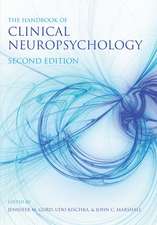The Fractal Geometry of the Brain: Advances in Neurobiology, cartea 36
Editat de Antonio Di Ievaen Limba Engleză Hardback – 13 mar 2024
The new edition of the highly popular, The Fractal Geometry of the Brain, reviews the most intriguing applications of fractal analysis in neuroscience with a focus on current and future potential, limits, advantages, and disadvantages. It brings an understanding of fractals to clinicians and researchers even if they do not have a mathematical background, and it serves as a valuable tool for teaching the translational applications of computational fractal-based models to both students and scholars. As a consequence of the novel research developed at Professor Di Ieva's laboratory and other centers around the world, the second edition will explore the use of computational fractal-based analysis in many clinical disciplines and different fields of research, including neurology and neurosurgery, neuroanatomy and psychology, magnetoencephalography (MEG), eye-tracking devices (for the fractal computational characterization of “scanpaths”),deep learning in image analysis, radiomics for the characterization of brain MRIs, characterization of neuropsychological and psychiatric diseases and traits, signal complexity analysis in time series, and functional MRI, amongst others.
| Toate formatele și edițiile | Preț | Express |
|---|---|---|
| Paperback (1) | 1395.00 lei 6-8 săpt. | |
| Springer – 20 iun 2018 | 1395.00 lei 6-8 săpt. | |
| Hardback (2) | 1173.14 lei 39-44 zile | |
| Springer – 3 aug 2016 | 1173.14 lei 39-44 zile | |
| Springer International Publishing – 13 mar 2024 | 1421.66 lei 6-8 săpt. |
Din seria Advances in Neurobiology
- 18%
 Preț: 1115.14 lei
Preț: 1115.14 lei - 18%
 Preț: 1384.26 lei
Preț: 1384.26 lei - 18%
 Preț: 1847.84 lei
Preț: 1847.84 lei - 18%
 Preț: 960.42 lei
Preț: 960.42 lei - 15%
 Preț: 645.79 lei
Preț: 645.79 lei - 18%
 Preț: 960.93 lei
Preț: 960.93 lei - 18%
 Preț: 1229.10 lei
Preț: 1229.10 lei - 18%
 Preț: 950.33 lei
Preț: 950.33 lei - 18%
 Preț: 1671.09 lei
Preț: 1671.09 lei - 18%
 Preț: 1116.71 lei
Preț: 1116.71 lei - 18%
 Preț: 959.98 lei
Preț: 959.98 lei - 18%
 Preț: 955.08 lei
Preț: 955.08 lei - 18%
 Preț: 948.79 lei
Preț: 948.79 lei - 18%
 Preț: 1230.66 lei
Preț: 1230.66 lei - 15%
 Preț: 648.42 lei
Preț: 648.42 lei - 18%
 Preț: 1010.17 lei
Preț: 1010.17 lei - 24%
 Preț: 897.47 lei
Preț: 897.47 lei - 18%
 Preț: 964.23 lei
Preț: 964.23 lei - 18%
 Preț: 945.47 lei
Preț: 945.47 lei - 18%
 Preț: 1222.69 lei
Preț: 1222.69 lei - 15%
 Preț: 641.38 lei
Preț: 641.38 lei - 18%
 Preț: 1222.31 lei
Preț: 1222.31 lei - 18%
 Preț: 1227.21 lei
Preț: 1227.21 lei - 18%
 Preț: 1843.91 lei
Preț: 1843.91 lei - 18%
 Preț: 1231.01 lei
Preț: 1231.01 lei - 18%
 Preț: 1111.97 lei
Preț: 1111.97 lei - 24%
 Preț: 957.42 lei
Preț: 957.42 lei - 18%
 Preț: 1228.62 lei
Preț: 1228.62 lei - 18%
 Preț: 1124.47 lei
Preț: 1124.47 lei - 18%
 Preț: 1394.38 lei
Preț: 1394.38 lei - 18%
 Preț: 1227.67 lei
Preț: 1227.67 lei - 18%
 Preț: 1263.82 lei
Preț: 1263.82 lei - 5%
 Preț: 1637.00 lei
Preț: 1637.00 lei - 24%
 Preț: 1156.95 lei
Preț: 1156.95 lei - 18%
 Preț: 948.92 lei
Preț: 948.92 lei
Preț: 1421.66 lei
Preț vechi: 1733.73 lei
-18% Nou
Puncte Express: 2132
Preț estimativ în valută:
272.10€ • 283.00$ • 228.02£
272.10€ • 283.00$ • 228.02£
Carte tipărită la comandă
Livrare economică 13-27 martie
Preluare comenzi: 021 569.72.76
Specificații
ISBN-13: 9783031476051
ISBN-10: 3031476050
Pagini: 1004
Ilustrații: XXIX, 1004 p. 285 illus., 211 illus. in color.
Dimensiuni: 155 x 235 mm
Greutate: 1.61 kg
Ediția:2nd ed. 2024
Editura: Springer International Publishing
Colecția Springer
Seria Advances in Neurobiology
Locul publicării:Cham, Switzerland
ISBN-10: 3031476050
Pagini: 1004
Ilustrații: XXIX, 1004 p. 285 illus., 211 illus. in color.
Dimensiuni: 155 x 235 mm
Greutate: 1.61 kg
Ediția:2nd ed. 2024
Editura: Springer International Publishing
Colecția Springer
Seria Advances in Neurobiology
Locul publicării:Cham, Switzerland
Cuprins
Part I. Introduction to Fractal Geometry and its Applications to Neurosciences.- The Fractal Geometry of the Brain: An Overview.- 2. Box-Counting Fractal Analysis: A Primer for the Clinician.- Tenets and Methods of Fractal Analysis (1/f noise).- 4. Tenets, Methods and Applications of Multifractal Analysis in Neurosciences.- Part II. Fractals in Neuroanatomy and Basic Neurosciences.- Fractals in Neuroanatomy and Basic Neurosciences: An Overview.- Morphology and Fractal-Based Classifications of Neurons and Microglia.- The Morphology of the Brain Neurons: Box-counting Method in Quantitative Analysis of 2D Image.- Neuronal Fractal Dynamics.- Does a Self-Similarity Logic Shape the Organization of the Nervous System?.- Fractality of Cranial Sutures.- The Fractal Geometry of the Human Brain: An Evolutionary Perspective.- Part III. Fractals in Clinical Neurosciences.- Fractal Analysis in Clinical Neurosciences: An Overview.- Fractal Analysis in Neurological Diseases.- Fractal Dimension Studiesof the Brain Shape in Aging and Neurodegenerative Diseases.- Fractal Analysis in Neurodegenerative Diseases.- Fractal Analysis of the Cerebrovascular System Physiopathology.- Fractal and Chaos in the Hemodynamics of Intracranial Aneurysms.- Fractal-based Analysis of Arteriovenous Malformations (AVMs).- Fractals in Neuroimaging.- Computational Fractal-Based Analysis of MR Susceptibility Weighted Imaging (SWI) in Neuro-oncology and neurotraumatology.- Texture Estimation for Abnormal Tissue Segmentation in Brain MRI.- Tumor Growth in the Brain: Complexity and Fractality.- Histological Fractal-based Classification of Brain Tumors.- Computational Fractal-based Analysis of the Brain Tumors Microvascular Networks.- Fractal analysis of electroencephalographic time-series (EEG-signals).- On Multiscaling of Parkinsonian Rest Tremor Signals and Their Classification.- Fractals and Electromyograms.- Fractal analysis in Neuro-ophthalmology.- Fractals in Affective and Anxiety Disorders.-Fractal Fluency: An Intimate Relationship Between the Brain and Processing of Fractal Stimuli.- Part IV. Computational Fractal-Based Neurosciences.- Computational Fractal-based Neurosciences: An Overview.- ImageJ in Computational Fractal-based Neuroscience: Pattern Extraction and Translational Research.- Fractal Analysis in MATLAB: A Tutorial for Neuroscientists.- Methodology to Increase the Computational Speed to Obtain the Fractal Dimension Using GPU Programming.- Fractal Electronics as a Generic Interface to Neurons.- Fractal Geometry meets Computational Intelligence: Future Perspectives.
Notă biografică
Antonio Di Ieva, MD, PhD, FRACS, is Professor of Neurosurgery at Macquarie Medical School, Macquarie University, Sydney, Australia; Professor of Neurosurgery, Ministry of Education, University and Research, Italy; Associate Professor of Neuroanatomy, Medical University of Vienna, Austria; Fellow of the Australian Research Council (ARC) and of the Royal Australasian College of Surgeons (RACS); Consultant Neurosurgeon, Macquarie Neurosurgery, Sydney, Australia; Founder and Head of the Computational NeuroSurgery (CNS) Lab at Macquarie University, Sydney, Australia; Neuroscience & AI Program Leader, Centre for Applied Artificial Intelligence, Macquarie University, Sydney, Australia
Textul de pe ultima copertă
The new edition of the highly popular, The Fractal Geometry of the Brain, reviews the most intriguing applications of fractal analysis in neuroscience with a focus on current and future potential, limits, advantages, and disadvantages. It brings an understanding of fractals to clinicians and researchers even if they do not have a mathematical background, and it serves as a valuable tool for teaching the translational applications of computational fractal-based models to both students and scholars. As a consequence of the novel research developed at Professor Di Ieva's laboratory and other centers around the world, the second edition will explore the use of computational fractal-based analysis in many clinical disciplines and different fields of research, including neurology and neurosurgery, neuroanatomy and psychology, magnetoencephalography (MEG), eye-tracking devices (for the fractal computational characterization of “scanpaths”), deep learning in image analysis, radiomics for the characterization of brain MRIs, characterization of neuropsychological and psychiatric diseases and traits, signal complexity analysis in time series, and functional MRI, amongst others.
Caracteristici
Provides a thorough, accessible overview of fractal analysis of the brain The only book to provide information on fractal analysis specifically for the neurosciences New areas include fractals in magnetoencephalography, deep learning in image analysis, and radiomics for brain MRIs
Recenzii
“This is a text about computer and mathematical modeling of basic and clinical Neurological Sciences. … Brain modelers would be interested in this book.” (Joseph Grenier, Amazon.com, June, 2018)















